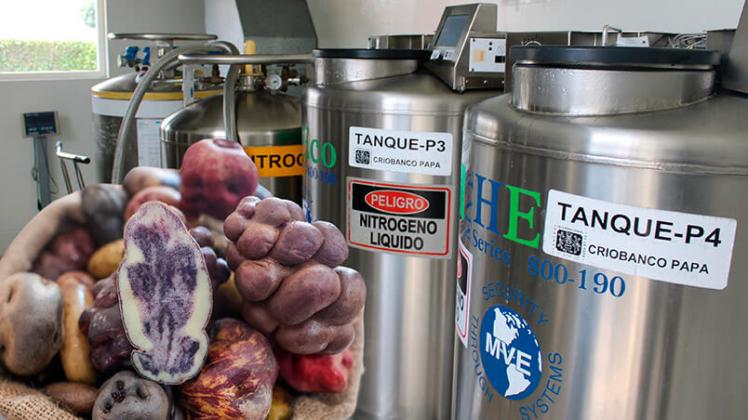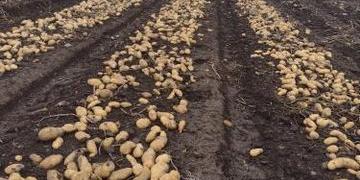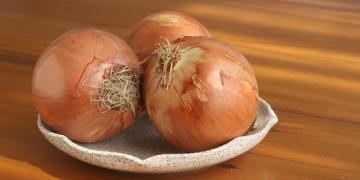Peru: The world’s largest potato cryobank is in Lima.
To safeguard the heritage of the Andes, in the La Molina district of Lima, there is a discreet building that houses one of the most important biodiversity collections in the world.

The International Potato Center (CIP), a global leader in the research and preservation of potatoes, tubers, and other Andean crops, safeguards thousands of varieties and species in its cryobank using cutting-edge technology.
This cryobank, equipped with liquid nitrogen tanks at temperatures of -196 degrees Celsius, functions as a security vault that ensures the preservation of the genetic material of crops key to global food security.
We spoke with M.Sc. Rainer Vollmer, the scientist in charge of the potato, sweet potato, and other Andean root vegetable cryobank at CIP, to understand how this system works and why its work is strategic not only for Peru but for the entire world.
What is cryopreservation and why is it important for crop conservation, M.Sc. Vollmer?
Cryopreservation is a biological conservation process that uses extremely low temperatures (in liquid nitrogen at a temperature of -196°C) to preserve the genetic material of plants, animals, and even humans. In the case of plants, shoots, buds, seeds, pollen, and other elements such as embryonic axes can be stored. It is one of the most innovative and efficient ways to conserve species, as it allows them to remain viable for periods that can exceed decades and even centuries. This method is fundamental, especially in a context of climate change, as it is like having "insurance" to guarantee agricultural biodiversity against extinction.
ꟷ Why is cryopreservation so important in addressing biodiversity loss?
Biodiversity loss has accelerated, particularly due to human intervention and the effects of climate change. In 2024, for the first time, the threshold of a 1.5°C global temperature increase compared to pre-industrial levels was exceeded, putting many species at risk. Cryopreservation offers a way to conserve agrobiodiversity, creating a “safe bank” that can operate long-term, regardless of natural disasters, climate shocks, or even pandemics, as demonstrated by the COVID-19 crisis. Compared to other conservation methods, it requires less human intervention and allows large amounts of genetic material to be stored with very few resources, making it sustainable and economical in the long term.
Science at the service of the future of food
ꟷ How does it work from a technical perspective and what advantages does it have over other conservation methods?
In practice, potato preservation uses the apical bud of the plant, which is carefully cut, treated with cryoprotective solutions, and placed in liquid nitrogen. This process ensures that the genetic material remains unaltered and free of pathogens. When thawed, it can germinate again in a special medium, generating a new plant within 60 days. One of the main advantages of this method over others is the ability to preserve original material for centuries, without time limits, and with incredible spatial efficiency: up to 2,000 potato varieties can be stored in one cubic meter. Furthermore, it is highly resilient to disasters, as it does not depend on electricity for preservation, and liquid nitrogen is sustainable, as it can be generated from the air anywhere in the world.
ꟷ What are the costs associated with cryopreservation and how do they compare with other forms of preservation?
Although the initial investment to establish a cryobank can be high due to the purchase of specialized equipment and staff training, the operating cost is relatively low. To put this into perspective, preserving a potato accession under in vitro conditions costs approximately $100 per year, while cryopreservation costs about $500 per accession initially, but once established, annual maintenance drops to just $7. This makes cryopreservation more economical in the long term, and after 5 to 6 years, it is more efficient than other methods.
ꟷ Which crops are prioritized for cryobank storage?
The CIP cryobank is the largest in the world in terms of the number of conserved potato varieties, with more than 4,600 accessions. It also houses some 600 sweet potato varieties. These varieties are crucial because they include genes for resistance to cold, water stress, salinity, and disease, which is vital to ensuring food security in the future. We also work with other Andean tubers such as olluco, oca, and yacón, and are in the process of expanding the collection to other important crops in Latin America.
A living vault for Peru and the world
ꟷ Will the cryobank also store genetic material from other countries?
Yes, CIP is expanding its work with other Latin American countries. This year, we expect to receive samples from Ecuador and Chile, including potato, peanut, and garlic varieties. CIP strictly respects international laws and agreements regarding the ownership of plant genetic resources, and received materials are stored and conserved without further manipulation or use, returning them to their countries of origin upon request.
ꟷ What other crops could benefit from long-term cryopreservation?
The CIP is not only dedicated to tubers, but also aims to research the cryopreservation of other important crops in Peru, such as grapes, avocados, and mangoes, in collaboration with Peruvian national universities. The goal is to ensure the conservation of key agricultural species that might not be adequately protected through other conservation methods.
Will the cryobank contribute to the preservation of endangered species?
That’s right. Cryopreservation can be applied to any plant species, and many crops that are endangered due to environmental changes or natural disasters can benefit from this process. It’s like a modern "Noah’s Ark," allowing genetic material to be recovered to restore species that would otherwise be at risk of extinction.
What is the significance of the opening of the CIP cryobank for Peru and Latin America?
The opening (November 21, 2024) of the cryobank at the CIP represents a fundamental step for Peru and all of Latin America, as it positions the region as a leader in the conservation of its agricultural biodiversity. Furthermore, it is a global benchmark in the use of cryopreservation to ensure future food security. This is a source of pride for Peru, as the country has one of the greatest diversities of crops and agricultural varieties in the world.
How does CIP’s cryobank compare to the Norwegian Global Seed Bank?
The Norwegian Global Seed Bank focuses primarily on the conservation of orthodox seeds, those that can be dried and preserved at temperatures down to -20°C. However, many key food crops, such as potatoes, sweet potatoes, plantains, and cassava, are clonally propagated and not conserved using orthodox seeds. CIP’s cryobank specializes in the conservation of these clonal crops and other crops propagated via recalcitrant seeds.
Is Peru ready to implement more cryobanks or a Global Seed Vault?
Although creating more cryobanks in Peru would require a significant initial investment, the CIP is willing to collaborate with universities, companies, or associations to expand small-scale cryopreservation to other regions of the country. In discussions with institutions such as the Jorge Basadre Grohmann National University in Tacna , possibilities for applying this technology locally are being explored.
ꟷ Is cryopreservation only viable for tubers or also for other crops?
Cryopreservation is applicable to a wide range of crops, not just tubers. It works with any plant organ, from small seeds to plant shoots. For clonal crops, such as potatoes, shoot tips are used. For recalcitrant seed crops, such as cacao, the seed embryo is used. It is a flexible process that can be adapted to different types of genetic material.
ꟷ What safety measures are in place to protect species in the event of natural disasters?
The cryobank is designed to withstand natural disasters such as earthquakes. We have also implemented a contingency plan with a backup facility in Huancayo , Junín region, ensuring that, should the main infrastructure be affected, the genetic collections can be safely recovered. The genetic material is shielded, protected in multiple layers, including a robust stainless steel cryotank and plastic boxes and vials, ensuring its preservation even under extreme conditions.
Your final words, MSc. Vollmer.
Thank you very much for the interview and for giving us the opportunity to share the work we do. From Lima, the CIP leads a silent but essential mission: conserving agricultural biodiversity for future generations. In a global scenario increasingly threatened by climate change and the loss of genetic diversity, this work is not only urgent but also strategic to guarantee global food security. For any questions about cryopreservation, please contact me via email: r.vollmer@cgiar.org
Fuente:




